| Senkamanisken | ||||||||||||||||||||||||||||||||||||||||||||||||||||||||||||||||
|---|---|---|---|---|---|---|---|---|---|---|---|---|---|---|---|---|---|---|---|---|---|---|---|---|---|---|---|---|---|---|---|---|---|---|---|---|---|---|---|---|---|---|---|---|---|---|---|---|---|---|---|---|---|---|---|---|---|---|---|---|---|---|---|---|
| Senkamanisken | ||||||||||||||||||||||||||||||||||||||||||||||||||||||||||||||||
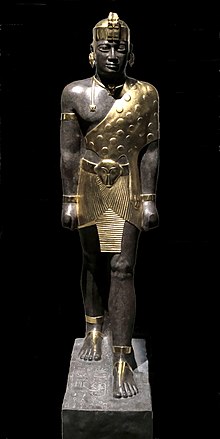 Senkamanisken statue, with Kushite headress (Louvre Museum, reconstruction of original colors through color-pigment analysis). Senkamanisken statue, with Kushite headress (Louvre Museum, reconstruction of original colors through color-pigment analysis). | ||||||||||||||||||||||||||||||||||||||||||||||||||||||||||||||||
| Pharaoh | ||||||||||||||||||||||||||||||||||||||||||||||||||||||||||||||||
| Kushite king of Napata | ||||||||||||||||||||||||||||||||||||||||||||||||||||||||||||||||
| Reign | c. 640–620 BC | |||||||||||||||||||||||||||||||||||||||||||||||||||||||||||||||
| Predecessor | Atlanersa | |||||||||||||||||||||||||||||||||||||||||||||||||||||||||||||||
| Successor | Anlamani | |||||||||||||||||||||||||||||||||||||||||||||||||||||||||||||||
Royal titulary
| ||||||||||||||||||||||||||||||||||||||||||||||||||||||||||||||||
| Consort | Nasalsa, Amanimalel, Masalaye ? | |||||||||||||||||||||||||||||||||||||||||||||||||||||||||||||||
| Children | Anlamani, Aspelta, Queen Henuttakhebit?, Queen Madiqen? | |||||||||||||||||||||||||||||||||||||||||||||||||||||||||||||||
| Father | Atlanersa ? | |||||||||||||||||||||||||||||||||||||||||||||||||||||||||||||||
| Mother | Queen Maletaral | |||||||||||||||||||||||||||||||||||||||||||||||||||||||||||||||
| Burial | Nuri (Nu. 3) | |||||||||||||||||||||||||||||||||||||||||||||||||||||||||||||||
Senkamanisken was a Kushite King who ruled from 640 to 620 BC at Napata. He used royal titles based on those of the ancient Egyptian pharaohs.
Biography
He might have been married to queens Amanimalel and Nasalsa, the latter of whom bore him two sons: Anlamani and Aspelta. Both sons would ultimately assume the Kushite throne after his death at Napata, Nubia's capital city. His pyramid is Nu.3 in Nuri.
Statues of Senkamanisken have been found buried or hidden in the Jebel Barkal, presumably due to Psamtik II's attack on Kush in 592 BC. A sphinx has also been found which was inscribed with his name. Objects bearing the name of this king have also been found in Meroë indicating that he placed a degree of importance to this site which would be the political capital of the Kushite kingdom after Psamtik II's sack of Napata in 592 BC.
He is the only Nubian king after the 25th Dynasty known from an inscription found in Egypt. He appears on a fragment of an offering table from Memphis.
Artifacts
-
 Senkamanisken statue, Kerma Museum
Senkamanisken statue, Kerma Museum
-
 Senkamanisken, Louvre Museum reconstruction, with pharaonic headdress.
Senkamanisken, Louvre Museum reconstruction, with pharaonic headdress.
-
 Senkamanisken portrait in the Kerma Museum
Senkamanisken portrait in the Kerma Museum
-
 Senkamanisken portrait in the Kerma Museum
Senkamanisken portrait in the Kerma Museum
-
 Senkamanisken, original in Kerma Museum, and Louvre Museum reconstruction through color-pigment analysis
Senkamanisken, original in Kerma Museum, and Louvre Museum reconstruction through color-pigment analysis
-
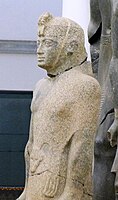 Senkamanisken, wearing the skin of a feline over his torso, Kerma Museum
Senkamanisken, wearing the skin of a feline over his torso, Kerma Museum
-
 An ushabti figurine of Senkamanisken, found in his tomb at Nuri
An ushabti figurine of Senkamanisken, found in his tomb at Nuri
-
 Statue of King Senkamanisken, Boston Museum of Fine Arts
Statue of King Senkamanisken, Boston Museum of Fine Arts
-
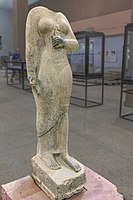 Queen Amanimalil, possible consort of Senkamanisken
Queen Amanimalil, possible consort of Senkamanisken
-
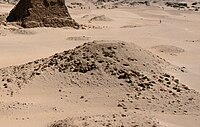 Ruins of the pyramid of Senkamisken at Nuri
Ruins of the pyramid of Senkamisken at Nuri
Temple B700 at Jebel Barkal
He also decorated Temple B700 (started by Aspelta) at Jebel Barkal, where he is shown clubbing enemies.
The hieroglyphic inscription on the Temple described the role of God Amun in selecting Sekamanisken as king:
I said of you (while you were still) in your mother's womb that you were to be ruler of Kemet ("Black Land"= Egypt). I knew you in the semen, while you were in the egg, that you were to be lord. I made you receive the Great Crown, which Re (the Sun god) caused to appear on the first good occasion. (Inasmuch as) a father makes his son excellent, it is I who decreed kingship) to you. (So) who shall share it with you? For I am the Lord of Heaven. As I give to Re, (so) he gives to his children, from gods to men. It is I who gives you the royal charter.... No other (can) decree (who is to be) king. It is I who grants kingship to whomever I will.
— Amun inscription, frieze of Sekamanisken, Temple B700, Jebel Barkal.
-
 Ruins of Temple B700 of Jebel Barkal with relief of Senkamanisken clubbing enemies, drawn in 1821 by Louis Maurice Adolphe Linant de Bellefonds
Ruins of Temple B700 of Jebel Barkal with relief of Senkamanisken clubbing enemies, drawn in 1821 by Louis Maurice Adolphe Linant de Bellefonds
-
 Senkamanisken slaying enemies in front of God Amun, at Jebel Barkal (pylon of building B 700, west of the main temple).
Senkamanisken slaying enemies in front of God Amun, at Jebel Barkal (pylon of building B 700, west of the main temple).
-
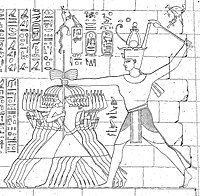 Senkamanisken slaying enemies at Jebel Barkal (detail).
Senkamanisken slaying enemies at Jebel Barkal (detail).
-
 Detail of the enemies
Detail of the enemies
References
- Török, László (1997). The Kingdom of Kush: Handbook of the Napatan-Meroitic Civilization. Brill. ISBN 978-90-04-10448-8.
- Dunham, Dows; Macadam, M. F. Laming (1949). "Names and Relationships of the Royal Family of Napata". Journal of Egyptian Archaeology. 35: 139–149. doi:10.1177/030751334903500124. S2CID 192423817.
- Welsby, Derek A./Julie R. Anderson (Hrsg.): Sudan, Ancient Treasurers, London 2004, S. 161, Nr. 144.
- Török, Laszlo; Hofmann, Inge; Nagy, István (1997). Meore City An Ancient African Capital. John Garstang's Excavations in the Sudan. pp. 235–41. ISBN 978-0-85698-137-1.
- Pope, Jeremy, 2020, Napatan Period. In Wolfram Grajetzki and Willeke Wendrich (eds.), UCLA Encyclopedia of Egyptology, Los Angeles. ISSN 2693-7425, p. 2.
- "Following their expulsion from Egypt by the Assyrians in 661 BC, the Kushites continued to develop the Barkal sanctuary . Atlanersa and Senkamanisken erected the small Temple B 700, which became a royal mortuary temple ." Sudan National Museum (2004). Sudan: Ancient Treasures : an Exhibition of Recent Discoveries from the Sudan National Museum. British Museum Press. p. 160. ISBN 978-0-7141-1960-1.
- ^ A Visitor's Guide to The Jebel Barkal Temples (PDF). 2016. pp. 97–98. Archived from the original (PDF) on 2017-04-05.
External links
| Preceded byAtlanersa | Rulers of Kush | Succeeded byAnlamani |
